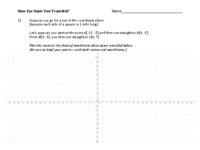
Distance in the Coordinate Plane (With Hints)
Discovery Lesson (Can be used without interactive figure below)
Angle Bisector Definition (I)
[color=#000000]In the applet below, the [/color][b][color=#1e84cc]blue ray[/color][/b][color=#000000] is said to be an [/color][color=#1e84cc][b]angle bisector[/b][/color][color=#000000] of [/color][b]angle [i]BAC[/i][/b][color=#000000]. [br][br]The [/color][b]gray slider[/b][color=#000000] adjusts the entire measure of [/color][b]angle [i]BAC[/i][/b][color=#000000]. [br][/color][color=#000000]The [b]black slider[/b] dynamically illustrates what it means for a [/color][color=#1e84cc][b]ray[/b][/color][color=#000000] to [/color][color=#1e84cc][b]bisect[/b][/color][color=#000000] an angle. [br][br][/color][color=#000000]Interact with this applet for a few minutes. [br]Then, answer the questions that follow. [/color]
1.
[color=#000000]From what you've seen, describe what it means for a [/color][color=#1e84cc][b]ray[/b][/color][color=#000000] to [/color][color=#1e84cc][b]bisect[/b][/color][color=#000000] an angle. [br][/color][b][color=#ff00ff]In your description, avoid using the words or phrases "[i]middle", "down-the-middle", "half"[/i]. [/color][/b]
2.
[color=#000000]Use the [b]Point on Object[/b] tool to plot a point F [/color][color=#1e84cc]anywhere on the [b]angle bisector[/b][/color][color=#000000]. [br]Use the [b]Angle[/b] tool to find and display the measure of angle [/color][i]BAF[/i][color=#000000] and [/color][i]CAF[/i][color=#000000]. [br][/color][color=#000000][br]How do these results reflect (i.e. illustrate) your response to (1)? [/color]
Differentiation: Example 2
Example 1
Example 2
YOUR Linear Speed?
[b]Students:[/b][br][br]Use this applet to help you complete the [i][color=#0000ff]How Fast Are You Spinning?[/color] [/i]investigation given to you at the beginning of class. [br][br]Some key questions to consider are listed below the applet.
1.
According to NASA's website, what is the Earth's mean equatorial radius?
2.
According to your answer for (1), what would Earth's circumference be?
3.
What would the linear speed of a person who lives on the Equator be? (Round your answer to the nearest 10 miles per hour).
4.
What is YOUR current latitude? (For Southern Hemisphere users, use a negative number. For Northern Hemisphere users, use a positive number.) .
5.
Use your answer for (3) and your result for (4) to determine YOUR LINEAR SPEED in miles/hr. (Round to the nearest 10 miles per hour). For a hint, interact with the applet above.
Slope (Quiz) I
[b]Directions:[/b][br][br]1) In the applet below, [b]note the slope displayed.[/b][br]2) Drag one (or both) of the white points to move the line [b]so that this line has this slope.[br][/b][br]3) Click the [b]"Check Your Graph"[/b] checkbox to determine if you're correct. [br] If the slope of your line matches the slope displayed, you'll see a [color=#ff00ff][b][i]"CORRECT"[/i][/b][/color] sign appear. [br] If your line does not have the slope displayed, you'll see a [b]"Not Correct"[/b] sign appear. [br] If this happens, try again. If you need a refresher, [url=https://www.geogebra.org/m/Xutr9rPj]click here[/url]. [br]
